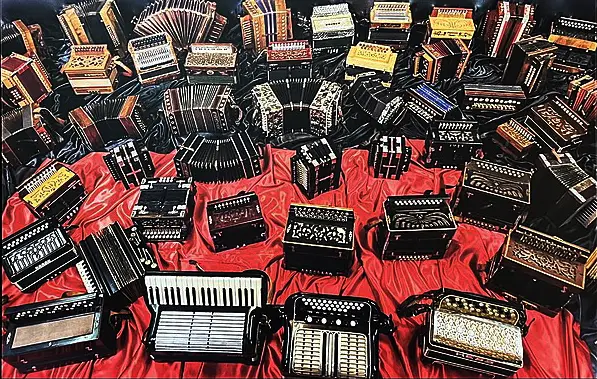
There are 2 main different families of accordions: diatonic and chromatic.
Diatonic accordions come in many different variations while chromatic accordions are mainly of 2 types: piano or button accordions.
For ease of categorization, I have separated accordions and concertinas into separate groups, as concertinas can be either diatonic or chromatic.
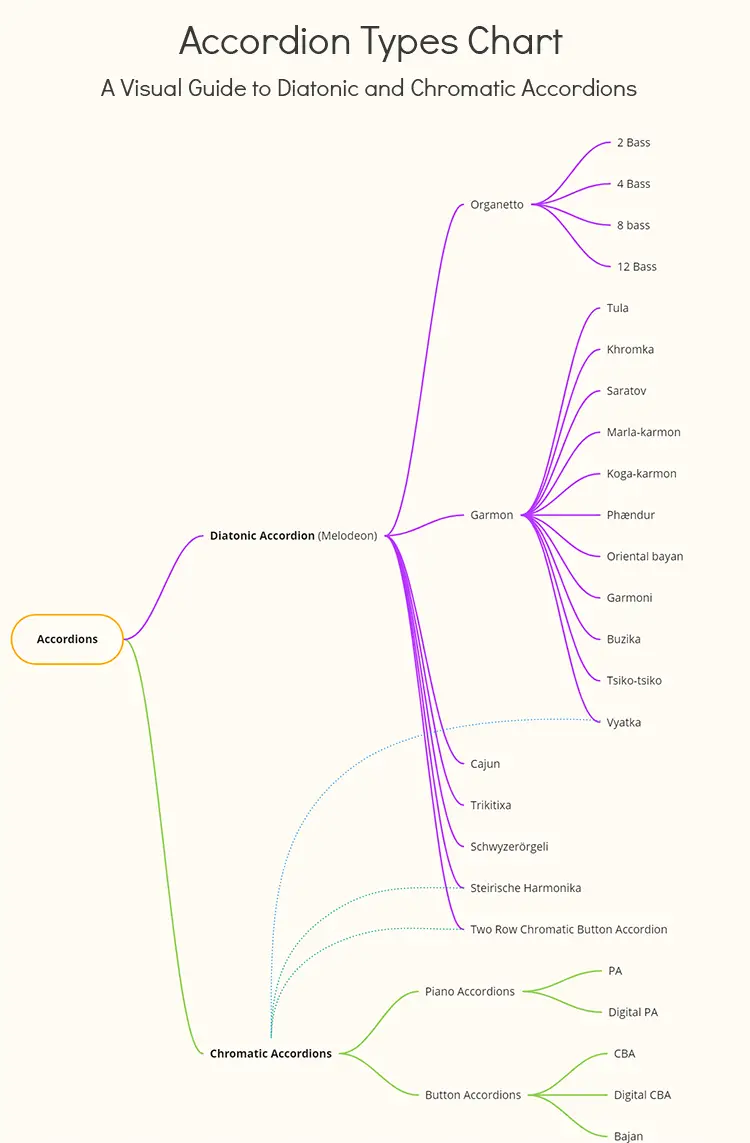
Why Are Called Diatonic and Chromatic Accordions?
The terms “diatonic” and “chromatic” are used to describe the type of musical scale that an accordion is designed to play and its ability to play a range of notes.
A diatonic accordion is designed to play music in a specific key and is limited to the notes within that key. It typically consists of 7 tones in a diatonic major or minor scale.
For example:

On the other hand, a chromatic accordion is designed to play any note within a full chromatic scale, which includes all 12 notes within an octave (7 whole tones and 5 accidentals).

Bisonoric vs. Unisonoric Accordions: What’s the Difference?
Accordions have a set of 2 reeds for each key, one reed vibrates when the bellows is pulled and the other when it’s pushed. When these 2 reeds are tuned to the same pitch, the accordion will play the same note regardless of whether the bellows are being pulled or pushed. This type of instrument is called a “unisonoric accordion” because it produces the same note on both bellows movements.
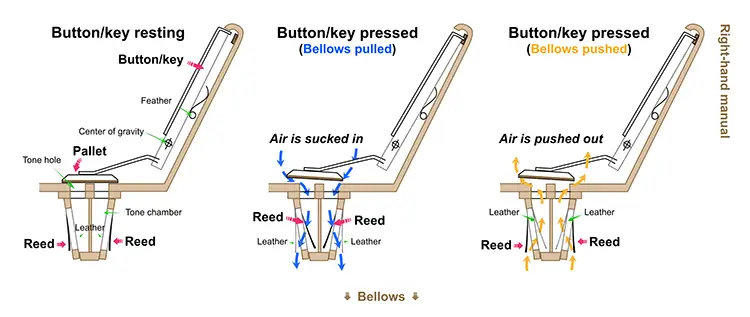
Some other types of accordion have a set of 2 different reeds for each key, so when you push the bellows, it plays one note and when you pull the bellows, it plays another note. This means that playing the same key while pushing or pulling the bellows will produce two different notes. This is why they are called bisonoric. because they play two different notes depending on the direction of the bellows movement.
Beyond Diatonic and Bisonoric
Since most diatonic accordions are bisonoric, it’s easy to think that all diatonic accordions are bisonoric and all bisonoric accordions are diatonic, but this is not always the case. There are bisonoric-chromatic accordions, such as the two-rows chromatic accordion, and diatonic-unisonoric accordions, like some garmons. There are even accordions that feature both bisonoric and unisonoric characteristics, such as the Schwyzerörgeli and Trikitixa. Keep in mind that not all accordions fit into neat categories and be open to discovering the unique features of each type.
Diatonic Accordions
As I just said, usually but not always, diatonic accordions are bisonoric instruments, meaning that the buttons will produce a different note when the bellows is pushed or pulled. They have a repeating pattern of buttons, each button corresponding to a specific note in the chosen key. This means that the accordion is limited to playing in one key at a time.

Different Types of Diatonic Accordions
Here’s a list of some of the most popular and widely used diatonic accordions around the world:
Melodeon
The Melodeon is a small, bisonoric instrument featuring from one up to 3 treble rows and, usually, 8 basses. It is a type of diatonic button accordion and is characterized by its compact size and simple bass button layout. The melodeon is commonly used in traditional English and Irish music, as well as in other genres such as folk and country.
The term “melodeon” is often used to refer to various types of diatonic accordions like the Italian Organetto.
Cajun Accordion
The Cajun accordion is a traditional instrument used in Cajun music, which is a genre of folk music that originated in Louisiana, USA. The Cajun accordion is a diatonic and bisonoric instrument, and the number of reeds that sound is controlled by four knobs that work as register switches. Usually, it has 10 keys on the right side, and 2 buttons on the left-hand side: one bass note and one major chord that can be played with each movement of the bellows, resulting in a total of 2 bass notes and 2 major chords.
Garmon
The garmon is a Russian diatonic accordion. It has a layout with 25 treble buttons arranged in two rows, and at least two rows of buttons on the left side, each with eight buttons. These bass buttons can play bass notes and chords, producing the primary chords in both the key of the instrument and its relative harmonic minor key.
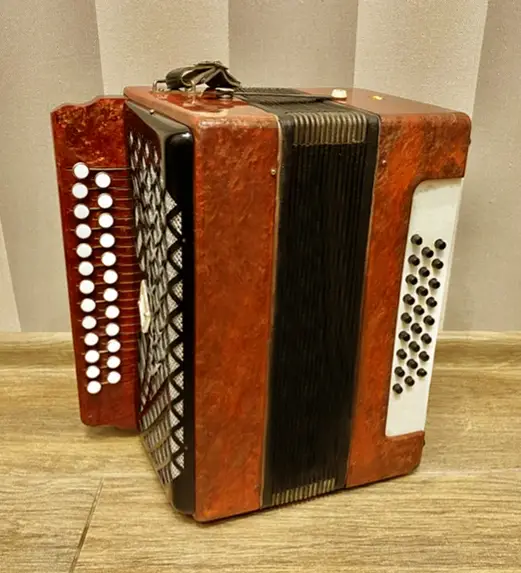
To enhance the playing experience, some garmons may have additional buttons on the right side or left side. Others may also include a row of free-bass buttons. As you can see in the chart, there are many types of garmon.
Garmons are typically bisonoric, meaning that different notes are produced when the bellows are pushed and pulled. However, there are also unisonoric garmons, which produce the same note regardless of the direction of the bellows movement, and even chromatic unisonoric garmons like the Vyatka. In the diagram, I’ve listed some of these variations. You can find more information about them on the Garmon Wikipedia page (link in “References“).
The Oriental bayan and the Vyatka garmon seem to be the only ones with a piano keyboard layout on the right-hand side.
Organetto
It’s a bisonoric diatonic accordion. The number of buttons on the treble side of the organetto can vary, depending on the type of instrument, from 12 to 33, arranged in 1, 2, or 3 rows.

The number of bass and chord buttons on the organetto ranges from a minimum of 2 to a maximum of 12. Among the various types of organetto, the most commonly used in traditional Italian music are the 2-bass and 8-bass versions, although 4-bass and 12-bass versions are also widely used.
Two-rows Chromatic Accordion
Over time and to meet the needs of artists, more and more notes have been added to the organetto and to other types of diatonic accordions, to the point of losing their diatonic nature. Therefore, it is a misconception to call “organetto”those chromatic accordions that allow playing the chromatic scale in one movement of the bellows.

Although they look completely similar, they should be differentiated from the diatonic types by calling them the more correct name of “two-rows chromatic accordion”. This is why they are linked by a dotted line to chromatic accordions in the chart at the start of this chapter.
Trikitixa
The Trikitixa (aka Trikiti) is a small-size, two-row diatonic, and half-bisonoric button accordion that is commonly used in Basque folk music.
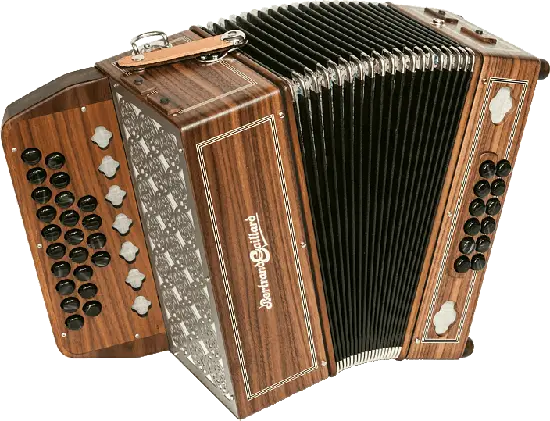
The term “bisonoric” refers to the fact that each button on just the right-hand side of the instrument produces two different notes. The right-hand rows are keyed a fifth apart, which allows the player to play a wide range of melodies, and the 12 unisonoric bass buttons provide rhythm and harmony.
Steirische Harmonika
The Steirische is a diatonic accordion commonly used in traditional folk music in the Alpine regions of Germany, Austria, Slovenia, South Tyrol (Italy), and Switzerland. It features 3 to 5 rows of treble buttons, allowing the player to produce a range of different notes and chords.
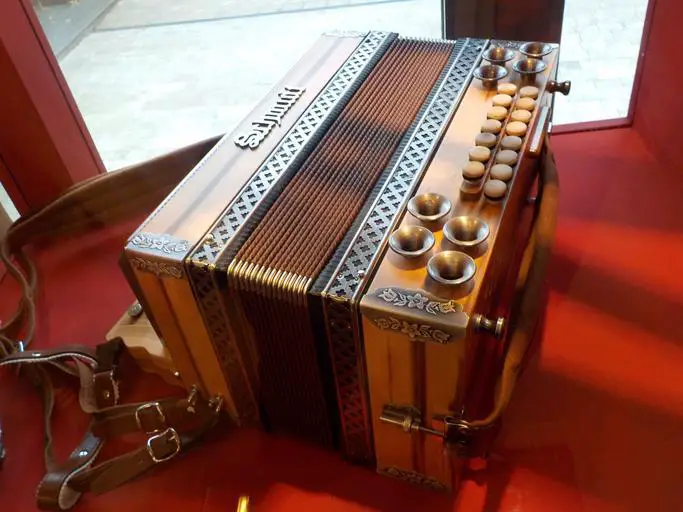
Known for its unique sound, the Steirische accordion has distinctive features such as the “Gleichton layout“, in which only one key per scale row is unisonoric while the rest are bisonoric, and the Helikon basses (invented by Franz Lubas in 1878). These basses are larger and more powerful than standard accordion bass reeds and are voiced in separate sound chambers, creating a vibrant, tuba-like sound that contributes to the distinctive character of the Steirische accordion. The Helikon basses are designed to produce a strong, deep, resonant low end, making the Steirische stand out in ensemble settings and supporting the melody in traditional folk music styles.
The Steirische accordion also has a chromatic version, known as the “Semi-chromatic,” or “12-bass chromatic.” The treble side of this version is unisonoric, similar to a standard chromatic accordion, and plays the same note in both bellows directions while the bass buttons are bisonoric and play different notes pushing or pulling.
Schwyzerörgeli
The Schwyzerörgeli is a small, diatonic accordion used in Switzerland, it has bisonoric treble and unisonoric bass. It is characterized by its compact size and simple layout: 31 treble buttons on the right side arranged in 3 treble rows and 2 bass rows (9 buttons each). The bass layout follows the fourths pattern seen in the Stradella system of chromatic and piano accordions, but in the opposite direction. It is often tuned to flat (♭) keys, which makes it easier to play along with instruments like the B♭ clarinet, which is typical in traditional Swiss music.
Concertinas
The concertina was developed simultaneously in England and Germany, resulting in five main types: English, Duet, Anglo (aka Anglo-German), Franglo, and German. Each type of concertina has distinct features, making them different from one another. Belong to this group even a very popular outsider in the world of accordions: the bandoneon.
English Concertina
The English Concertina is chromatic and unisonoric. It typically has 48 keys divided between the two sides with alternating notes, meaning the notes written on the lines of the stave are on one side and those on the spaces are on the opposite side. This arrangement is deliberately designed to facilitate sheet music reading, as the instrument was originally intended to perform classical music.

On both sides, the buttons are arranged along four vertical rows, with two central rows for the natural notes and two lateral rows for the sharps and flats. The standard range is three octaves and a fourth, which in the soprano model goes from G below middle C to the C three octaves above, just like the violin. The English Concertina is supported by the musician’s thumbs through adjustable leather straps, while two metal “L” shapes allow the little fingers to support some of the weight.
Duet Concertina
The duet concertina is a unisonoric and chromatic instrument, similar to the English concertina, but it features the lower notes on the left side and the higher notes on the right side.
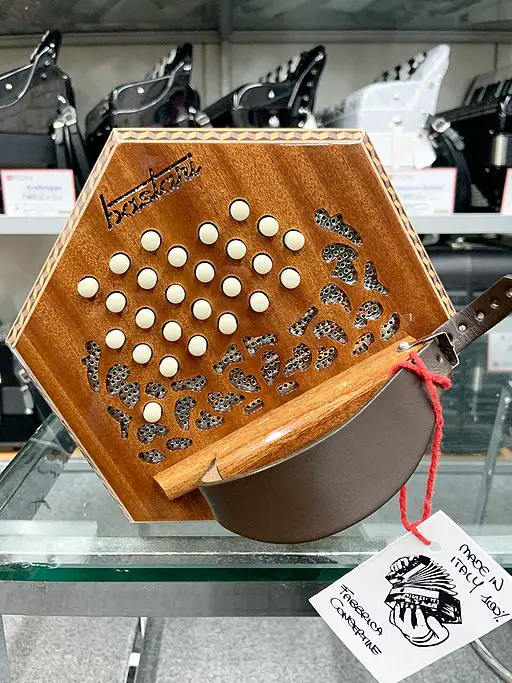
The Duet system includes several key layouts, the most common being the Maccann, the Crane, the Jeffries, and the Hayden system, which is an isomorphic system with a uniform arrangement of scales and intervals. Despite being a more recent development, the majority of newly-produced Duet concertinas since the 1980s are in the Hayden system.
Anglo Concertina
The Anglo concertina has a diatonic setup and each button produces two different notes when opening and closing the bellows (bisonoric). It was born as a blend of the English concertina and the German diatonic accordion.
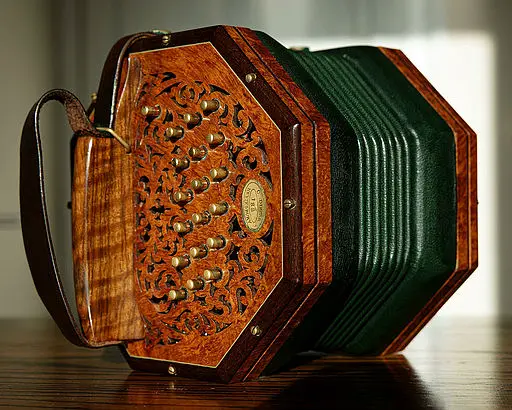
Anglo concertinas are commonly used in Irish music, English Morris dance, and Boeremusiek.
The lower notes are played with the left hand and the higher notes with the right hand. The instrument has two adjustable leather straps for the player’s hands, leaving the thumbs outside. The right thumb is used for a side air button that allows the bellows to be closed without producing sound.
3 Rows Anglo Chromatic Concertina
In addition to the standard Anglo concertina, there is also the 3 rows Anglo-chromatic concertina. This variation has an additional row of buttons that provide access to the missing notes in the standard layout, allowing for a wider range of melodies and keys to be played.
Franglo Concertina
The Franglo concertina has the melodeon layout, featuring three rows on the right-hand side and bass buttons on the left-hand side. It is worth noting that both the treble and bass notes produce a single voice, whereas the chords on the left-hand side play the root and the fifth. Basically, it’s a concertina-shaped instrument that features three rows, similar to those found on a melodeon.
German Concertina
German concertinas are characterized by their square shape and larger size compared to English concertinas. They are typically bisonoric and sometimes are wet-tuned.
Chemnitzer Concertina
The Chemnitzer concertina is primarily a diatonic accordion, however, there are also some rare models that are chromatic..
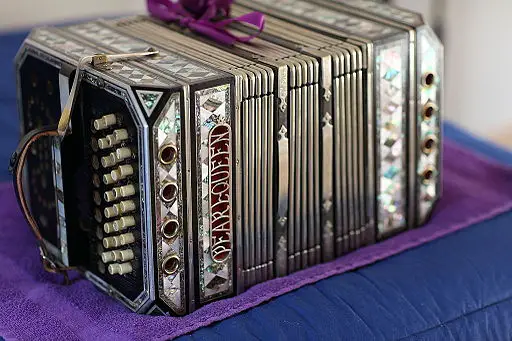
Bandoneon
The Bandoneon is a unique type of concertina accordion that was invented in the late 19th century by German inventor, Heinrich Band. Note that there are different types of bandoneons, typically they are bisonoric instruments but there is also a chromatic version. Its purpose was to provide a more affordable and portable alternative to liturgical organs.
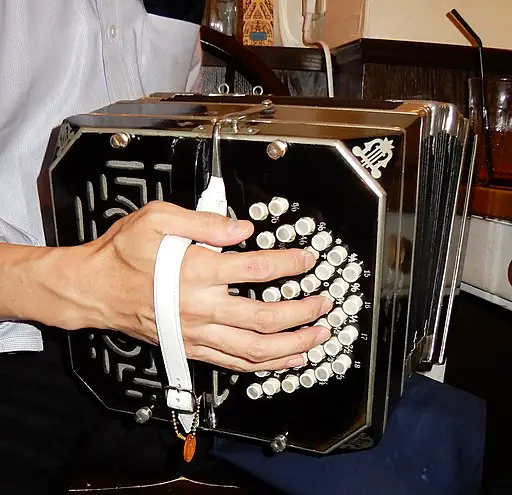
The instrument was later introduced to Argentina by immigrants and became a central part of the tango music culture. Today, the bandoneon is most commonly associated with Astor Piazzolla, who is famous for his contribution to the creation of the “Nuevo Tango” style, a fusion of traditional tango and other musical genres.
Bisonoric Bandoneon
The bisonoric bandoneon refers to those instruments where pressing the same key produces two different sounds depending on the direction of the bellows. The chaotic layout of the keys may seem like a disadvantage at first, but it allows for two different execution schemes for the same musical structure, and it is very ergonomic to play with the hand “trapped” by a belt. The bisonoric bandoneon is recommended for those who have time to get familiar with the two keyboards and need to play bandoneon solo repertoire or the “classic” one.
Unisonoric Bandoneon
The unisonoric bandoneon, on the other hand, produces the same sound whether opening or closing the bellows. Its keyboards have a chromatic layout that makes them easier to learn. The unisonoric is recommended for those who need to play within a short time, for example, professionals who need to quickly set up a program and then make gigs or concerts. However, the chromatic bandoneon is the ideal instrument for those musicians who want to play a limited bandoneon repertoire without spending years memorizing the chaotic bisonoric’s keyboards.
Modern Use of Diatonic Accordions
Diatonic accordions have a rich history in folk and traditional music, but today they are widely used in many musical styles, especially those that incorporate modern influences with classic elements (Indie, World Music, New Wave, etc.).
One of my favorite bands that feature the diatonic accordion is KV Express. Here’s a playlist of some of their tracks:
Chromatic Accordions
Chromatic accordions are capable of playing any note, enabling the player to play in any of the 12 keys. These instruments are unisonoric, meaning they have two reeds for each note, allowing the accordion to produce the same note whether the bellows are pushed or pulled.
There are two main types of chromatic accordions, CBA (Chromatic Button Accordions) and PA (Piano Accordion):
Both the CBA and PA accordions have the Stradella bass system (or some version of it like free bass, Belgian system, French system, CJS system) on the left side.
Chromatic Button Accordions (CBA)
Stradella bass accordions with buttons on the treble side are called Chromatic Button Accordions (CBA) and can have a wider range of notes on the treble side than accordions with piano keys. This is because the buttons on a chromatic accordion are arranged in 3 or 5 rows, with the fourth and fifth rows duplicating the first and second, allowing for more efficient use of space and, therefore, a wider range of notes and fingering options.
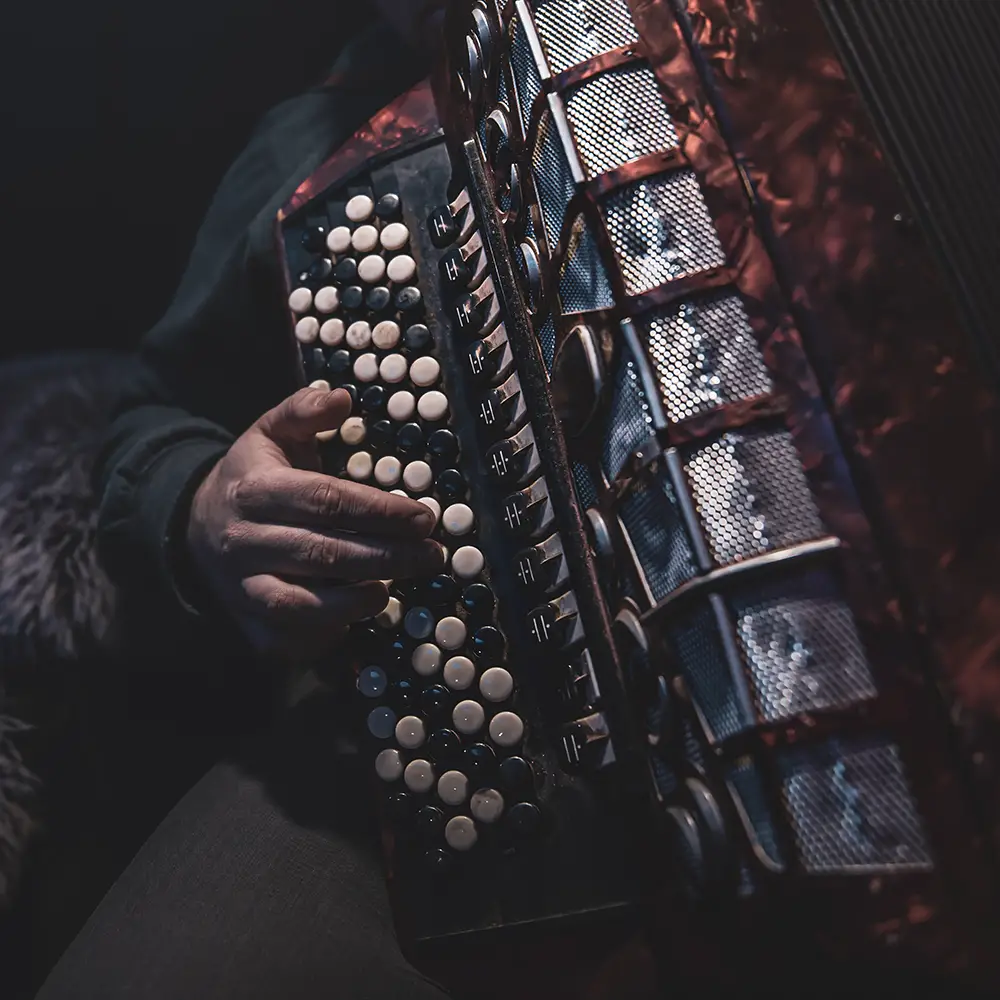
The layout of the right side of a chromatic accordion is modular, which means that chords, scales, arpeggios, and melodies can be played using the same fingering in any key, you just need to start playing from a different position on the button board. It also allows you to play an octave without having to stretch your hand as you would on a piano keyboard. This means that you can play arpeggios, scales, and complex extended chords more easily than on a piano accordion.
C Griff and B Griff Layouts
Chromatic button accordions come in two different layouts: C Griff and B Griff. So what are they? Well, both of them have the same basic structure – higher notes on the bottom, and lower notes on the top of the button board. However, they differ in where the “C” note is located. In the C system, you’ll find it on the first row, while in the B system, it’s on the third row from the right. they’re rare and only available in the C system.

The B system is more commonly used in Eastern Europe, Russia, and Norway, while the C system is popular in Western Europe. These instruments may be hard to find depending on where you live, especially in Australasia and North America where they’re rare and only available in the C system.
Bayan Accordions
The Bayan is a CBA that differs from Western chromatic button accordions in several key aspects. The reeds are broader and rectangular, and the reed plates are attached in groups rather than pairs, it is only tuned with dry tuning, and the diminished chord rows are positioned differently from the Stradella bass system. A Bayan often has a switch to convert from standard preset chords to free bass. These differences in construction and tuning contribute to the Bayan’s unique tone color and full bass sound. It’s no wonder that it’s favored by some of the world’s most skilled classical accordionists like Alexandr Hrustevich
Piano Accordions (PA)
Standard bass accordions with piano keys on the treble side are called Piano Accordions (PA), and have a more limited range of notes on the treble side (usually 41 keys on a 120 bass) than a CBA of the same size. This is because the keys on a piano accordion are arranged in a keyboard layout, which can be less efficient in terms of space and note range.
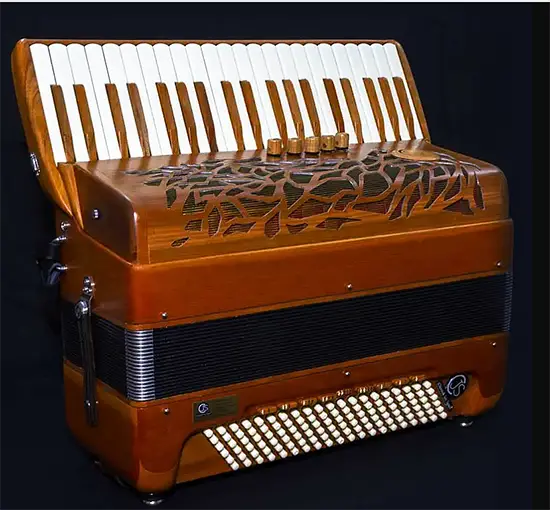
While the layout of a piano accordion is visually more intuitive due to the linear arrangement of the notes, making it easier to understand intervals and harmony, it is also less ergonomic for the hand compared to the chromatic accordion layout. The hand must adjust to different keys, and the player is often required to make big stretches to play large interval jumps, arpeggios, etc.
Despite these limitations, the piano accordion is still a favorite among many renowned and talented accordionists. This demonstrates that the limitations do not diminish the reliability and capability of the instrument. In fact, the piano accordion remains a popular choice for many accordion enthusiasts and professional musicians.
Check out this selection of piano accordions on *ThomannMusic.com
Alternative Piano Keyboard Layouts
The Uniform layout: https://boxandfiddlearchive.weebly.com/the-uniform-keyboard.html
The Kravtsov’s Keyboard layout: http://www.accordionkravtsov.ru/eng/sys.shtml
The Finto Piano layout: https://www.accordionists.info/threads/finto-piano.1042/
Digital Accordions
Digital accordions are an alternative option for both piano and button accordion players.

Digital accordions typically have a full-size keyboard and offer a wide range of sounds, from synthesized traditional accordion tones to other instrument sounds like piano, organ, and more.
Conclusion
In conclusion, understanding the differences between diatonic and chromatic accordions, as well as bisonoric and unisonoric accordions, is crucial to finding the instrument that suits your needs. Diatonic accordions are designed to play music in a specific key and typically consist of 7 tones in a diatonic major or minor scale. On the other hand, chromatic accordions, like piano or button accordions, are designed to play any note within a full chromatic scale, which includes all 12 notes within an octave. Keep in mind that not all accordions fit into neat categories, and each instrument may have unique features that make it worth exploring.
References
Diatonic Accordion Resources
If you’re interested in learning more about diatonic accordions, I recommend visiting the Melodeon.net forum or the Wikipedia page about diatonic accordions. There’s a lot to explore, as there are many different types of diatonic accordions, each with its own unique features, layout, and key arrangement.
Garmon: https://en.wikipedia.org/wiki/Garmon
Organetto: https://www.organetto.it/Pagine/organetto.html
Steirische Harmonika: https://en.wikipedia.org/wiki/Steirische_Harmonika
Bayan: https://en.wikipedia.org/wiki/Bayan_(accordion)
Schwyzerörgeli: https://en.wikipedia.org/wiki/Schwyzerörgeli
Concertinas: http://www.concertina.com/
Chemnitzer concertina: https://en.wikipedia.org/wiki/Chemnitzer_concertina
Bandoneon: https://www.omarcaccia.com/bandoneon-keyboard-showdown-unisonoric-vs-bisonoric/
List of Diatonic Accordion Brands and Retailers
Hohner (Germany)
Bompezzo (Italy)
Castagnari (Italy)
Dino Baffetti (Italy)
Mengascini (Italy)
Serenellini (Italy)
Fismen (Italy)
Giustozzi (Italy)
Dina Baffetti (Italy)
Saltarelle (France)
Bernard Loffet (France)
Bertrand Gaillard (France)
Wesson Accordion Company (UK)
Briggs Accordions (UK)
Squeezeboxes.co.uk (UK)
Cairdin (Ireland)
Marc Savoy (Cajun – USA)
Liberty Bellows (USA)
Hyde Accordions (Australia)
Author: Giovanni Lucifero
*AccordionChords is affiliated with ThomannMusic.com. If you click on a link to ThomannMusic.com and make a purchase, I may earn a commission. This commission helps keep our website running and allows us to provide valuable content. Thank you for your support!

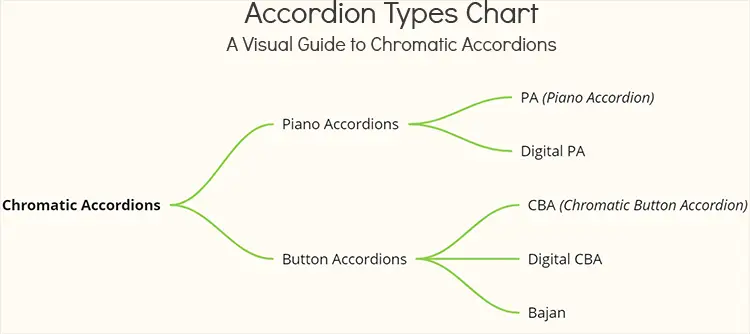
Very interesting and useful information. Thanks for sharing it!
Thanks Luis! 🙂